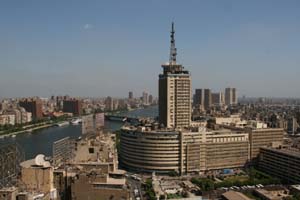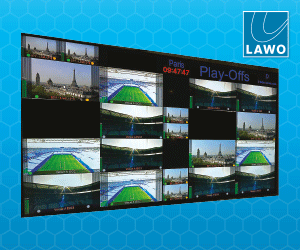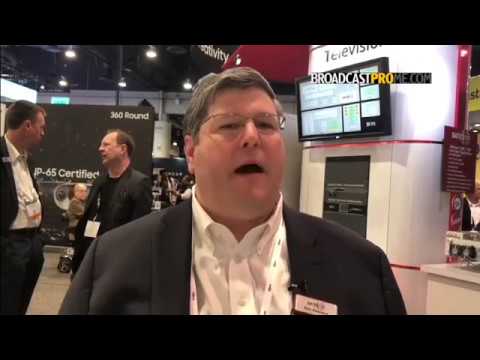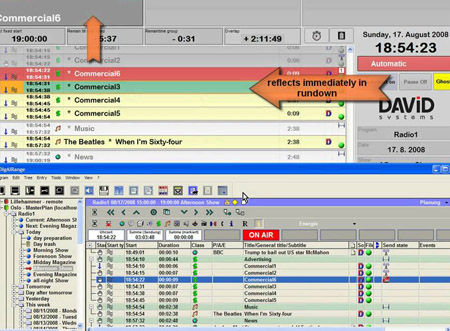Egypts national broadcaster ERTU replaced its existing radio infrastructure with a state-of-the-art solution encompassing automation and archiving. In an exclusive interview with Vibhuti Arora, systems supplier and integrator SCISYS shares the details of the project Egyptian Radio and Television Union (ERTU), Egypts national broadcaster, recently overhauled its radio facilities. The USD 2.5m project was undertaken […]
Egypts national broadcaster ERTU replaced its existing radio infrastructure with a state-of-the-art solution encompassing automation and archiving. In an exclusive interview with Vibhuti Arora, systems supplier and integrator SCISYS shares the details of the project
 Egyptian Radio and Television Union (ERTU), Egypts national broadcaster, recently overhauled its radio facilities. The USD 2.5m project was undertaken by German solutions provider SCISYS in conjunction with its local partner Interact Computer Stores.
Egyptian Radio and Television Union (ERTU), Egypts national broadcaster, recently overhauled its radio facilities. The USD 2.5m project was undertaken by German solutions provider SCISYS in conjunction with its local partner Interact Computer Stores.
The objective of the project was to replace ERTU’s first generation radio automation system with a state-of-the-art broadcast solution for its 22 radio channels. The project also entailed the installation of a long-term audio archive with a capacity of up to 500,000 hours of audio.
Rather than deploying just another radio automation system, ERTU called for the implementation of a comprehensive enterprise-wide answer to the challenging demands of a modern public service broadcast station. The system needed to be installed at ERTUs headquarters in Maspero.
SCISYS deployed its Dira (branded as dira!) radio automation system and its radio archive system to cater to ERTUs multiple requirements.
Dira is a modular production and playout solution for radio. It supports the complete workflow of a radio organisation encompassing audio acquisition and ingest, material and programme exchange, pre-production and editing, media asset management, scheduling and long-term programme planning, manual, semi-automatic and automatic on-air playout, broadcast reporting and reconciliation, post-production, archiving as well as integrated system management.
For each of these domains the Dira product line offers appropriate software modules. Various configuration options provide solutions for different network formats such as current affairs, information and service networks, mainstream programmes and classic or religious networks.
With 40 production studios, 21 on-air studios and 125 workstations for journalists daily producing, scheduling and playing out 50 national and international programmes, this installation is one of the largest broadcast radio systems in the region. It runs 24/7 in multiple languages. To facilitate regional studios communicating with the headquarters in Maspero, Dira Mediapool is used as a web-client to download and upload material via the web.
The turnkey project was carried out in two phases by SCISYS. Phase one included the delivery of all material installation and its factory acceptance testing at its factory in Bochum, Germany as well as the implementation of fibre. Phase two of the project comprised on-site installation of the broadcast solution and training for ERTU’s staff.
The new solution enables ERTU to stay on-air with its scheduled programme regardless of any unpredictable events that may interfere with the daily routine. In addition to the main system in Maspero, a dedicated recovery system at a second site, serves as a fail-safe and can run independently.
The on-site implementation, including infrastructure, final configuration, training and a three-month trial period, took less than one year. However, the delivery was handed over to ERTU only in late summer last year, owing to the unexpected delay caused by political disturbances in Egypt.
Although the shipment arrived at customs in Cairo in January 2011, the political situation in Egypt prohibited the uninterrupted on-site resumption of the project. Instead, the delivery of 19 wooden boxes with high-tech broadcast equipment remained at the airport customs and later, at the ERTU warehouse. It was only after political recovery in Cairo, almost two years later, that the project was revived.
The solutions
Several hundred radio professionals were required to concurrently work across several enterprises on an integrated solution that allows for efficient collaboration between ERTUs diverse broadcast operation covering 50 national and international programmes in 30 different languages.
The multi-pronged project came with its own set of challenges, explains Wael Yasin, Key Account Manager at SCISYS.
One of the challenges for SCISYS was to provide a solution that catered for operating a radio production system in a multilingual environment, he says.
The key requirement of the project was an uninterrupted 24/7 on-air operation including the radio operators access to media assets and related programme schedules at any point in time, regardless of potential power losses, unavailability of network connections or even emergency cases, where access to the broadcast building is impossible.
In order to serve ERTU with the maximum possible performance and resilience, SCISYS deployed a combined production, playout and archive system on a mirrored server and storage platform and so, provided full data replication over three locations,” he adds.
The collaborative use of the Dira radio production and playout system and the Dira digital audio archive solution is an important element in ERTUs infrastructure. It allows users to search, browse and access content from both databases, and easily transfer it into their work context.
The Dira Multisite feature provides seamless access to both, the Dira digital audio archive as well as the Dira production and playout system.
The new solution replaced an IBM/Jutel Radio Man system that takes all aspects of an enterprise broadcast operation into account. The delivered solution comprises a server-client based architecture driven by the Dira Archserv asset management server component forming a middle layer between the MS SQL server and all connected client applications. Around 42,000 audio items together with its respective metadata have been migrated from an IBM DB2 database to the Dira Archserv database that is based on MS SQL.
The production and broadcast automation system aims to cover the entire audio production and playout processes. Beginning with the audio acquisition, journalists ingest their content as file or stream, which goes to MAM. Once available in MAM, the ingested material runs through the production and approval processes before it is made available for programme planners. Only items declared as ready for transmission are accessible to the dedicated playout outlets.
Commenting on the scope of the project and how it was successfully executed, Michael Pridat, Technical Project Manager, SCISYS Deutschland GmbH says: Overall, it was a fascinating and challenging project in a demanding environment. One of the key success factors in the project was the setup of our partner network in Cairo. Our on-site representation EgyptPlus, the systems integrator Interact and our on-site engineer Ismael Youssry reliably supported us, especially in days where we could not be on-site at ERTU ourselves.
The installation of a digital audio archive is one of the highights of the project. This hard-disk based storage system integrates seamlessly with the production system, both of which are accessed using the Dira Highlander client. The scalable archive stores up to 190,000 hours of audio at this stage with the scope for expansion to store ERTUs 500,000 hours of audio heritage.
The audio library seamlessly integrates into the production and playout process. Automatic archiving of produced content is crucial as is easy search, retrieval and transfer of archived content back to the playout system.
The server and storage back-end is split into two halves across two floors. If either floor is not available the system can still work without operational limitation. The client workstations are deployed across seven floors with 21 on-air studios and 40 production studios.
An online storage area network (SAN) solution was chosen against the near-line and off-line LTO solutions for the formers long-term advantages.
We suggested storing each audio asset on two mirrored in-house SAN instances as well as another mirrored off-site instance connected via a lease-line Ethernet network connection. In case any one or two of the instances are not available, one remains accessible for the provision of requested data. This architecture ensures that all content remains available at any point in time for immediate access and avoids the requirement for the restoration of time-intense backups, in case one or two of the SAN instances fail, explains Yasin.
ERTU decided to have an emergency broadcast centre at a different location, where SCISYS installed the third instance of the core system. The site provides independent facilities including fully equipped studios. All content and programme schedules are mirrored in real-time to the third site once created at Maspero. It is just a matter of moving staff to the emergency broadcast centre, loading a broadcast plan to the on-air workstation and opening a fader on the mixing console to start operations from there.
The workflow
Planning a broadcast, acquiring and finding material, editing audio, scheduling the actual running order and playing out the scheduled items are the main tasks in radio production. To execute these, the editor requires a tightly integrated, comfortable and powerful suite of tools whose core is the editorial client. Further on, flexibility and compatibility are expected from those tools on existing systems.
Instead of separate user interfaces and applications for various content types, like spoken word and script items, Dira presents a single, unified front end to all media stocks without sacrificing any metadata quality. Dira Highlander allows for an arbitrary number of metadata sets through the definitions of views on the audio material and secondary items, which include presenter texts and notes.
The integrated system management solution Dira ISM enables the administrators and support staff to monitor the overall health of the system, says Mona Wahdan, Manager of Automation System at ERTU.
It includes software processes and hardware. In case of support requests or system health alarm messages, minimum response times are achieved as we can directly to the respective workspace and take action, she explains.
Dira Highlander, however, only provides the user with the information actually valid for a certain item in a user-configurable view that can present the most relevant information first. The actual metadata set available to an item is determined when creating it, by selecting an appropriate, pre-defined template for the piece. The amount of data on any template is completely up to the customer, items with a need for a large amount of metadata can be presented in a tabulated window, thus separating information needed at first glance from detailed, but less frequently accessed information.
With the capability to have any hierarchy of stores in their personal area, journalists can collect all relevant material in one place. Subsequently, any audio can be placed to the schedule or called up for editing, thus providing a seamless integration with all other required tools.
Third-party applications such as advertisement management or craft editing are integrated making use of Dira connect or API technology.
Multi-track edits of the built-in editors created on one edit workstation can be completed at any other location even a different site within the network with the third party craft editor from Magix Sequoia.
Commenting on the successful execution of the project, Amira Sharabia, Head of Central Directorate for Studio Projects at ERTU says: ERTU is proud of the completion of this important project. The new system tightly integrates all involved radio sub-systems of our broadcast operation. This includes the new digital archive, the disaster recovery site and also the regional sites. The new radio broadcast automation and archive system is customised to exactly meet ERTUs demands. Its future-oriented design offers scalability towards expansions whenever necessary.
Key equipment
Infrastructure:
2x Cisco ASA 5500 series firewalls
2x Cisco Catalyst 6500 series backbone switches
20x Cisco 2960-S series Gigabit floor switches
Vertical fibre network infrastructure with 10 Gigabit Ethernet uplinks
Horizontal copper network infrastructure with Gigabit TCP/IP connection
5 km fibre cables
30 km UTP cables
15 km audio cable
5 km power cable
5 fully equipped 42 HU racks
IT solutions:
10x HP DL 380 servers
34x HP P2000 storage enclosures
More than 400 TB of hard-disk based storage
125x HP z400 workstations
22x dedicated SCISYS engineered on-air keyboards
120x digital RME soundboards










































































